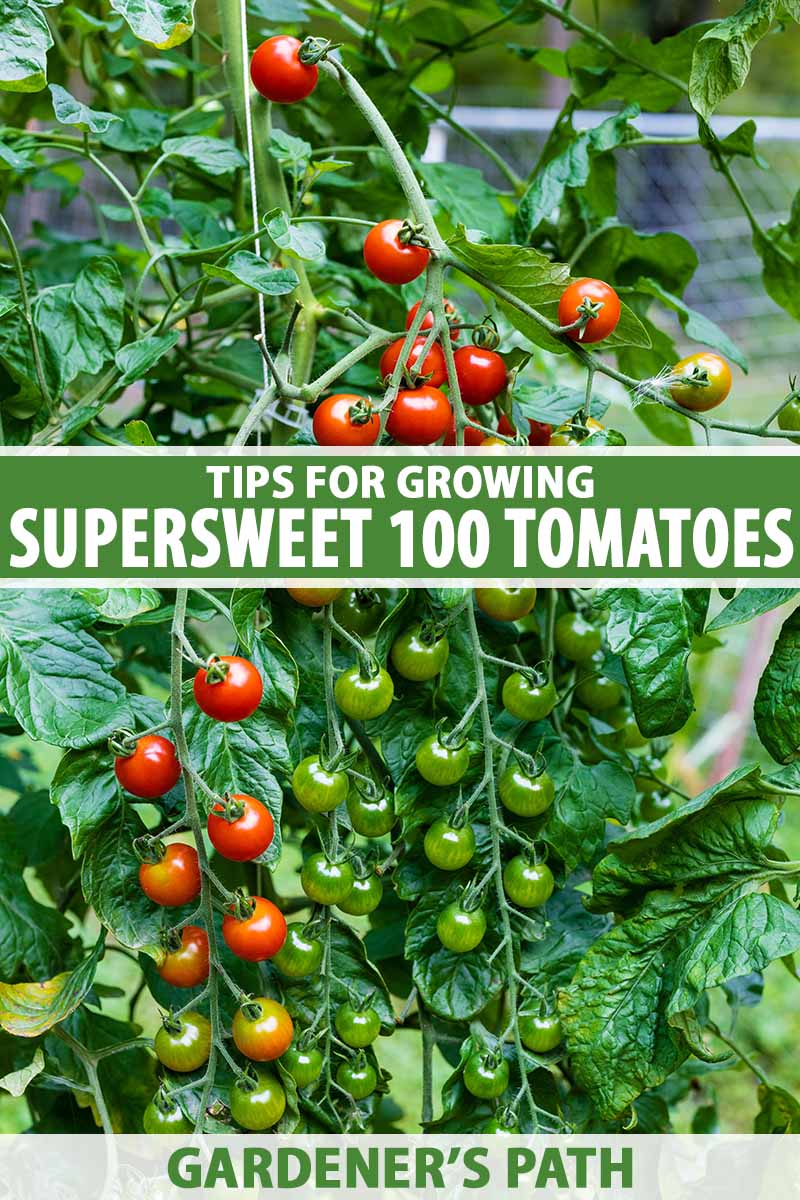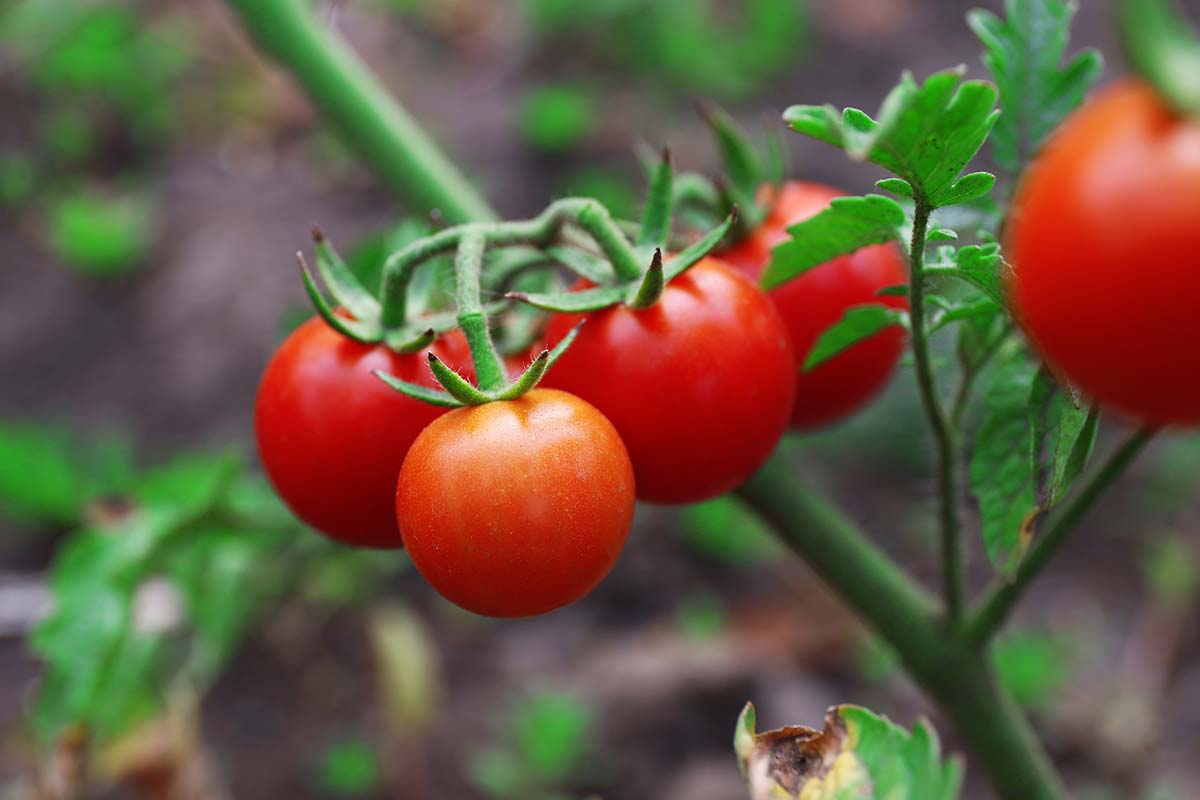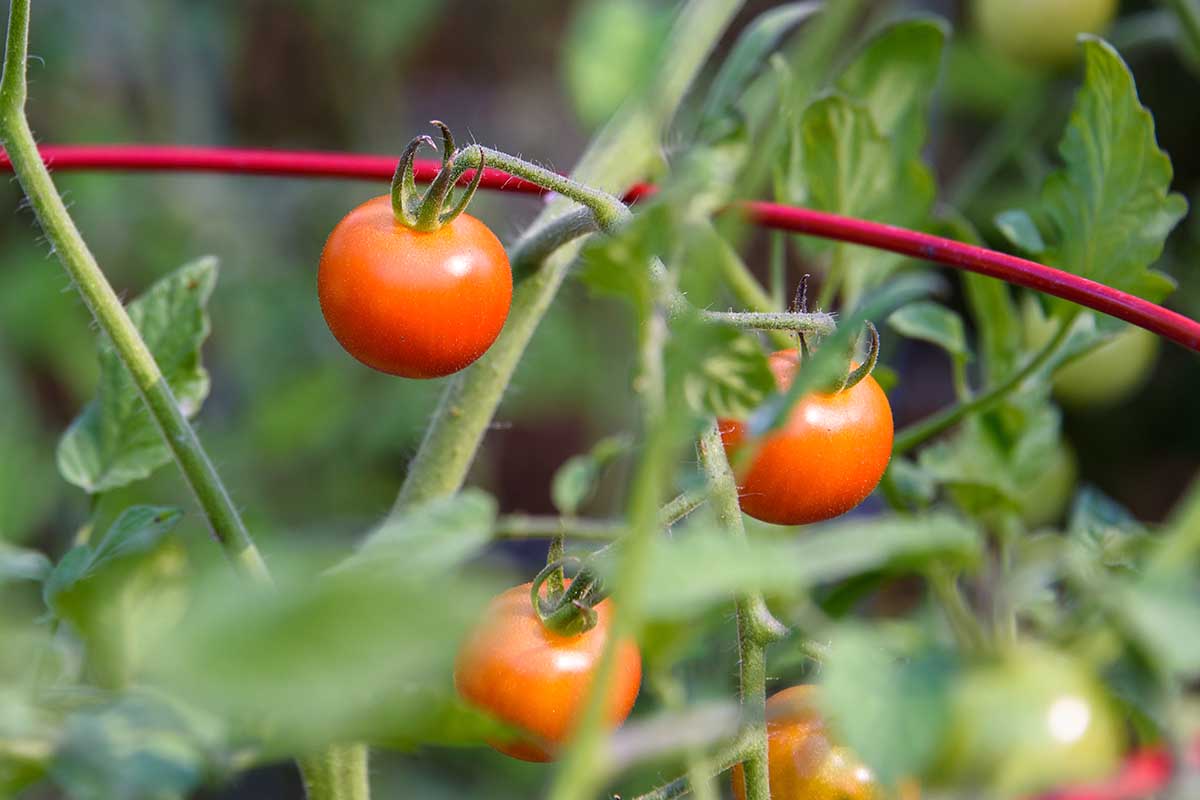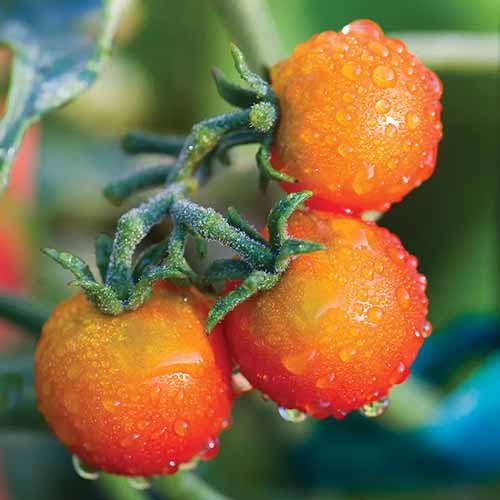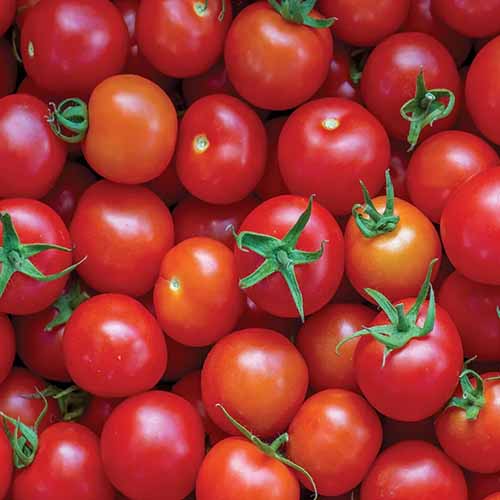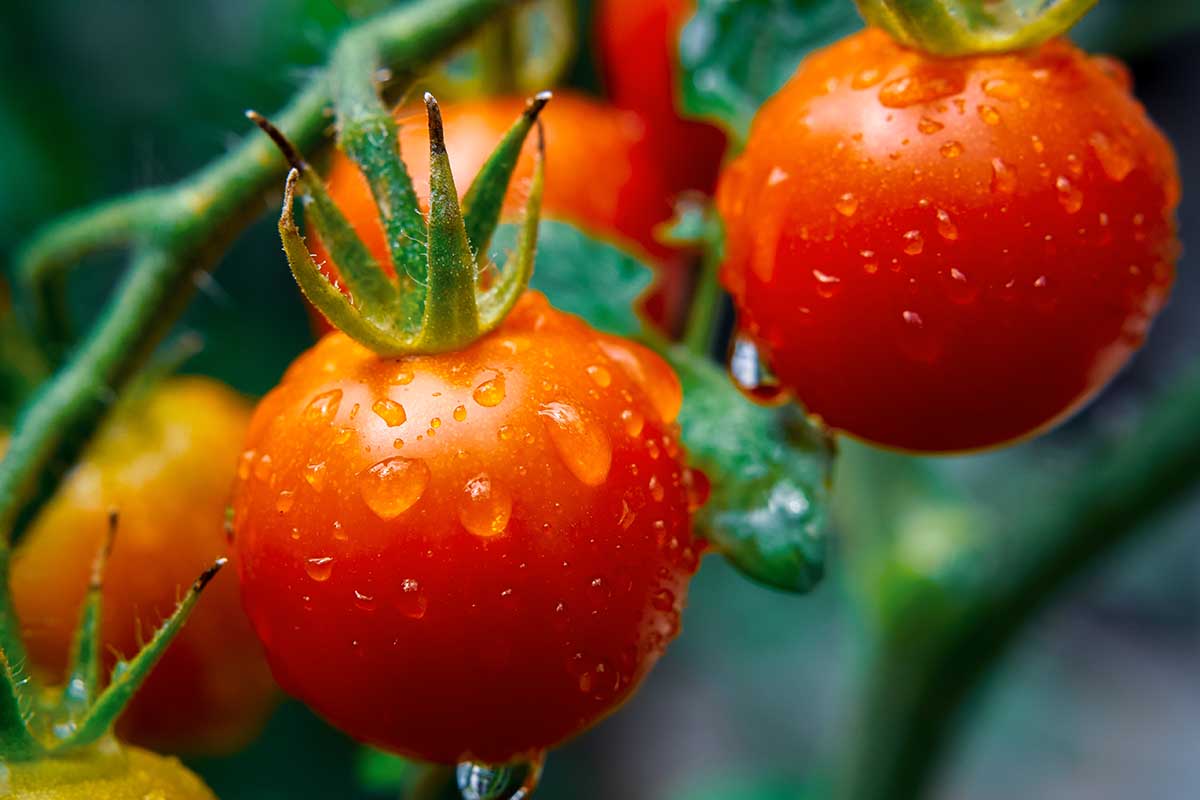‘Supersweet 100’ tomatoes go in the opposite direction. We link to vendors to help you find relevant products. If you buy from one of our links, we may earn a commission. And that’s just the start. Grown properly and given ample support, they can yield upwards of 500 tomatoes each, over a long season. If that sounds appealing, why not get to know a little more about this cultivar? I’ll share some of its history, and then share some growing tips. Here’s what I’ll cover:
What Are Supersweet 100 Tomatoes?
Known as ‘Supersweet 100’ or sometimes ‘Super Sweet 100,’ this cherry tomato was not the first to arrive on the scene with abundant yields and an extra sweet flavor. That would be its parent plant, ‘Sweet 100,’ which shook up the tomato scene with its introduction by the Northrup-King Seed Company in Minnesota, in 1978. As the story goes (and it may be just a story), the sample plant came from row 100 at the field trial, and a European gent was splattered with the juice, but only amiably responded that “100 was a sweet little devil.” With its fast growth, high yields, and sugary fruits, the variety quickly gained popularity. But it was supplanted by this hybrid, introduced by the same company in 1982. Their aim was to preserve the good traits of the parent while introducing resistance to verticillium wilt, fusarium wilt, and nematodes. Today, even the cultivars marketed as ‘Sweet 100’ are more likely to be the newer hybrid. This cultivar is grown across the US, and it is especially valued for its early harvest, which begins just 60 to 65 days from transplanting. Some call it a “candy” tomato, so sweet are the one-inch fruits. It’s also considered a “pole variety,” since the plants are vines, not bushes, and able to grow higher than 10 feet, though heights in the four- to eight-foot range are most common. ‘Supersweet 100’ is also famed for its long growing season, since it begins to produce a harvest ready for picking earlier than other varieties. An indeterminate type of tomato, it sets fruit over the course of the season, right up until the first frost. You can learn more about growing tomatoes in general and cherry tomatoes in particular in our guides. But also take a few minutes to familiarize yourself with the specific needs of this powerhouse cultivar. That info is coming right up. Read on!
How to Grow
Anytime you hear of a particular variety of vegetable that delivers abundantly, there’s a catch. A bumper crop is only guaranteed when you provide the plants with proper care throughout the season. To maximize yield with ‘Supersweet 100,’ consider these tips:
Carefully Select Where to Grow
There are a few special considerations when you want to grow this cherry hybrid. First, remember that the vines will spread about two feet and reach at least four feet tall. You’ll need a location where they have enough room to spread, and also where it’s feasible to give them the support they’ll need. You can grow one plant in a container if this is a better option for you than growing in the ground, but this may require more effort than what you’d need to put in with a different cultivar. ‘Supersweet 100’ is not a dwarf variety. These plants will grow tall, and require plenty of water and nutrition. The minimum container size for an indeterminate tomato vine like this is five gallons, with drainage holes in the bottom and a saucer below to catch any overflow. That can be pretty heavy, even with a rolling plant stand beneath it. And choose a spot that’s easy to reach for watering duties. Especially in the summer, you won’t want to have to go too far to give the plants that inch or so of water they need each week – or more if they’re growing in containers. ‘Sweetheart of the Patio,’ for example, has been bred to grow in containers, and grows about two feet tall. ‘Sweetheart of the Patio’ You can find 10-seed packets or live plants of this variety from Burpee. You’ll also want to grow at least a couple plants within easy reach of the casual nibbler. There’s nothing more pleasant than popping a couple of ripe “candy” tomatoes into your mouth while hanging out on the patio on a casual evening with friends, or plucking a few from a plant close to the back door right before you toss that evening’s salad.
Assure an Early Harvest
The rule of thumb here is to plant out tomatoes a couple of weeks after the average last frost in your area. Learn how to start tomatoes from seed in our guide. But if you live in a region with a short growing season, or you just want to have tomatoes that are ready to eat as soon as possible, you can go ahead and transplant this cherry variety under a row cover just as your last frost date occurs – after hardening off the plants, of course.
Plant ‘Em Deep
These prolific producers need healthy roots and strong stems to support the multitudes of fruit that appear over the long season. You can help both roots and stems to get established by stripping the side suckers off of the plants, and planting seedlings well below the soil line, with just the top four inches of each seedling emerging above ground. This will encourage the roots to grow stronger and the stems to be sturdier. And while it might seem like this would slow down the harvest window, the plants shoot up and make up the lost height pretty quickly.
Provide Plenty of Support
The fruits are petite, but not the vines. ‘Supersweet 100’ will need support to keep the fruit off the ground and provide the air circulation that keeps foliage dry, so it can resist infestations and diseases like powdery mildew. The plants will reach at least four feet tall and could grow as high as seven or eight feet, or sometimes more, when receiving full sun, adequate water, and proper nutrition. Since the vines are supporting clusters of small fruits, they can topple or break if they’re not trellised. Tomato cages provide ample support if that’s what you’ve got, but only use ones that have openings that allow you to comfortably slip your hands inside to pick. When you can’t easily reach the ripening fruit, it’s hard to harvest. Since there are so many individual fruits to harvest, and the plants will only keep producing if you pick diligently as they ripen, I recommend forgoing the cages and training the vines to climb trellises, fence panels, or lattice weave supports. All of these options offer better access to ripe fruits. You’ll probably need to tie the stems to the supports, at least to start, but be sure to make a loose tie. Use a material that’s gentle and/or biodegradable, like strips of cotton fabric or sisal twine. Don’t use plastic ties that can cut into the stems, or (shudder!) zip ties that can injure the plants, as well as being difficult to remove at season’s end. Learn more about creating a Florida Weave support in our guide. This is a great option for growing tomatoes.
Prune as Needed
If you don’t want the plants to get too tall, pruning is a great idea. Use sterile scissors to clip off the tiny growths (known as suckers) from beneath the first hearty branch that has produced flowers. Do this ahead of when the plant sets its first fruits, which usually happens a couple of weeks into the summer. This approach helps the plant produce fruits further up the vine, where they’ll have better support and be easier to spot. It also keeps lower branches from touching the soil, which may contain pathogens that can infect the plant tissue. Pruning can also keep the plants from growing beyond the height where you can easily pick the tomatoes. This can, of course, decrease ultimate yields as well. But you might find it’s the best option if you’re growing in a container or small space.
Harvest Consistently
It’s hard to envision a time when it would become a chore to pick these delicious, sweet morsels, but ‘Supersweet 100’ plants can be a lot to keep up with! You will want to pick all the ripe fruits every day or two throughout the season, as soon as they start turning red on the vine. This level of frequency is necessary to keep the plants productive, but also to keep the fruits from splitting on the vine, which can give disease pathogens a place to take hold.
Recipes and Cooking Ideas
Could you ever get tired of eating fresh, ripe ‘Supersweet 100’ tomatoes straight from the vine at snack time? I know I couldn’t! ‘Supersweet 100’ Live Plants You can find live plants available from Burpee. ‘Supersweet 100’ Seeds If you’d like to grow this variety from seed, various packet sizes and bulk sacks are available from True Leaf Market.
Preserving
Ripe cherry tomatoes are ideal for dehydrating or sun-drying. Find instructions for using a dehydrator for this purpose on our sister site, Foodal. They can also be dried in the oven. You’ll find instructions for doing that on Foodal as well. And finally, check out our guides to storing or freezing tomatoes for more tips and ideas on preserving the harvest. But these homegrown veggies can be used as an ingredient in various recipes, too, from the simple to the more intricate. They’re a natural in delightful summer dinner salads, for example, including Foodal’s recipe for summer corn salad with gorgonzola cheese and balsamic vinegar. And don’t count them out for main dishes, either, like Foodal’s take on shrimp and cherry tomatoes with feta cheese. And then there are all the garnishes, gazpachos, taco toppings… Lucky for you, if you’ve done a good job growing and caring for your ‘Supersweet 100’ plants, you’ll have as many tomatoes as you need to try dozens of new recipes. ‘Supersweet 100’ is a superstar in that category, providing snacks, salad toppers, and sun-dried veggies starting just 60 or so days from transplant, with more ripe for the picking until cold weather arrives. The only misrepresentation in that name is not that it doesn’t produce 100 tomatoes exactly, but that a healthy, well-tended plant can yield 1,000 or more fruits over the course of a season in ideal conditions. Wow! Have you tried growing this cherry variety, or do you still need information on some aspects of care that I didn’t cover here? The comments section below is available for you to share tips and ask questions. And if this guide was helpful, you can learn more about growing and caring for tomatoes in these guides next:
How to Plant and Grow Brandywine Tomatoes17 of the Best Cherry Tomatoes to Plant in Your GardenThe Top 10 Reasons to Love Tomatoes and Add More to Your DietHow to Grow Sweeter Tomatoes in Your Garden
